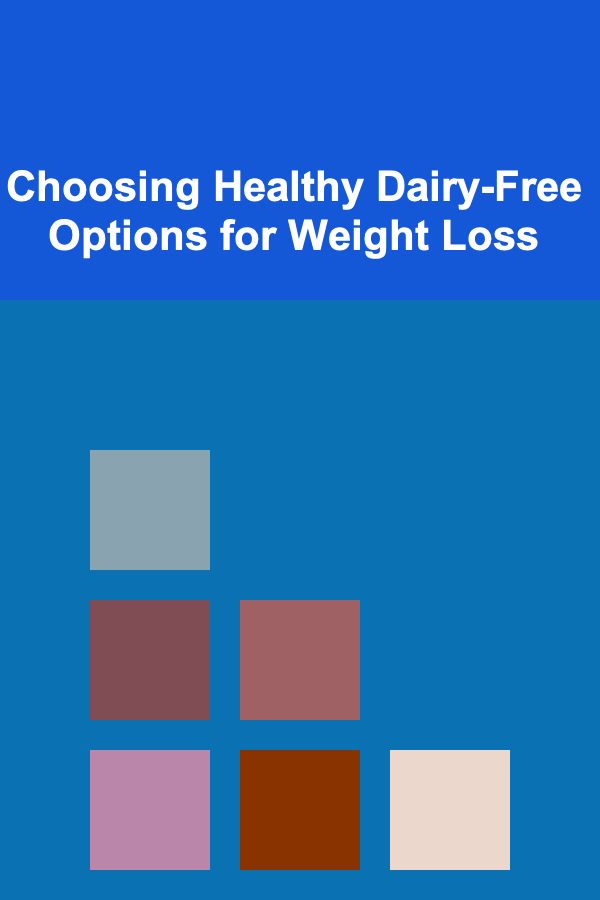
Choosing Healthy Dairy-Free Options for Weight Loss
ebook include PDF & Audio bundle (Micro Guide)
$12.99$7.99
Limited Time Offer! Order within the next:

Introduction: Navigating the Dairy-Free Landscape for Weight Management
In recent years, the dairy-free lifestyle has gained significant popularity. Driven by factors ranging from lactose intolerance and milk allergies to ethical concerns and perceived health benefits, more individuals are exploring alternatives to traditional dairy products. For those seeking to lose weight, navigating the dairy-free landscape can be both exciting and challenging. While simply eliminating dairy might seem like a direct route to weight loss, it's crucial to understand the nutritional implications and potential pitfalls of relying solely on substitutes. This article provides an in-depth guide to choosing healthy dairy-free options that support weight loss, covering nutritional considerations, product selection strategies, and practical tips for incorporating these alternatives into your daily diet. We will delve into understanding why dairy-free isn't automatically synonymous with weight loss, the importance of informed substitutions, and the key nutrients to consider when making the switch.
Why Dairy-Free Isn't Automatically a Weight Loss Strategy
Many assume that eliminating dairy inherently leads to weight loss. This misconception stems from several factors. Firstly, dairy products are often associated with higher fat content, particularly saturated fat. Cutting out whole milk, cheese, and ice cream might seem like a logical step to reduce overall fat intake. Secondly, some individuals experience digestive discomfort from dairy (even without a formal lactose intolerance diagnosis), and eliminating it can reduce bloating and improve digestive health, leading to a flatter stomach and the illusion of weight loss. However, the reality is more complex.
The problem lies in the potential for replacing dairy with less nutritious, processed alternatives that are high in sugar, unhealthy fats, and calories. For example:
- Sweetened Dairy-Free Milks: Many almond, soy, and oat milks are heavily sweetened to improve taste and mask the inherent flavors of the base ingredient. These added sugars contribute to excess calorie intake and can hinder weight loss efforts.
- Dairy-Free Desserts and Processed Foods: Dairy-free ice creams, yogurts, and other desserts often rely on refined carbohydrates and unhealthy fats (like coconut oil in large quantities) to mimic the texture and taste of their dairy counterparts. These products can be calorie-dense and low in essential nutrients.
- Over-Reliance on Carbohydrates: Simply removing dairy without a planned replacement can lead to an over-reliance on carbohydrates to fill the void, potentially spiking blood sugar levels and hindering fat burning.
Therefore, a successful dairy-free weight loss approach requires careful planning, informed product selection, and a focus on nutrient-dense alternatives that support a healthy and balanced diet.
Key Nutrients to Consider When Going Dairy-Free
Dairy products are a significant source of several essential nutrients, so it's crucial to find adequate replacements when eliminating them from your diet. The primary nutrients of concern are:
- Calcium: Crucial for bone health, muscle function, and nerve transmission. Dairy is a readily available and absorbable source of calcium.
- Vitamin D: Works synergistically with calcium to promote bone health and plays a vital role in immune function. Many dairy products are fortified with Vitamin D.
- Vitamin B12: Essential for nerve function and red blood cell production. Dairy is a natural source of B12.
- Protein: Important for satiety, muscle building, and overall metabolic health. While dairy isn't the only source of protein, it is a convenient and complete protein source.
- Potassium: Important for maintaining healthy blood pressure and fluid balance.
Failing to replace these nutrients adequately can lead to deficiencies and potential health problems. The following sections will outline how to obtain these nutrients from dairy-free sources.
Choosing the Right Dairy-Free Milk Alternatives
Dairy-free milk alternatives are widely available, but their nutritional profiles vary significantly. Here's a breakdown of popular options and considerations for weight loss:
Soy Milk
Soy milk is a complete protein source, meaning it contains all nine essential amino acids. It's also naturally rich in calcium and potassium. Opt for unsweetened varieties to minimize added sugar. Soy milk tends to be higher in calories than some other milk alternatives, but the protein content can contribute to satiety.
Look for "unsweetened soy milk" on the label. Check the ingredient list for added sugars like cane sugar, corn syrup, or other sweeteners.
Almond Milk
Almond milk is low in calories and fat, making it a popular choice for weight loss. However, it's also low in protein and naturally contains very little calcium. Choose fortified varieties to ensure you're getting adequate calcium and Vitamin D. Be mindful of added sugars, as many brands are sweetened.
Read the nutrition label carefully to check for calcium and Vitamin D fortification. Look for varieties with at least 30% of the daily value (DV) for calcium.
Oat Milk
Oat milk has a creamy texture and a slightly sweet flavor. It tends to be higher in carbohydrates than almond or soy milk, but it also contains fiber, which can promote satiety and digestive health. Choose unsweetened varieties and be aware of the higher carbohydrate content if you're following a low-carb diet.
Oat milk can be a good option for adding creaminess to coffee or oatmeal, but be mindful of portion sizes due to the carbohydrate content.
Coconut Milk (Beverage vs. Canned)
It's important to distinguish between coconut milk beverage (sold in cartons) and canned coconut milk. Coconut milk beverage is diluted and generally lower in calories than canned coconut milk. Canned coconut milk is very high in fat, particularly saturated fat, and should be used sparingly, even though it can contribute a creamy texture to certain dishes. The beverage version may be fortified with calcium and Vitamin D, so check the label.
Use canned coconut milk sparingly in curries or sauces. Opt for the light version if available. Coconut milk beverage can be used in smoothies or as a milk substitute in baking.
Rice Milk
Rice milk is naturally sweet and very low in fat. However, it's also low in protein and nutrients. It can have a higher glycemic index compared to other milk alternatives, meaning it can raise blood sugar levels more quickly. It's generally not the best choice for weight loss, especially for individuals with diabetes or insulin resistance.
Pea Milk
Pea milk, made from yellow split peas, is a relatively new contender in the dairy-free milk market. It's a good source of protein and contains calcium and Vitamin D (usually added). It also has a neutral flavor, making it a versatile option for various uses.
General Tips for Choosing Dairy-Free Milk Alternatives:
- Always choose unsweetened varieties.
- Check for calcium and Vitamin D fortification. Aim for at least 30% of the Daily Value (DV) per serving.
- Consider the protein content. Soy milk and pea milk are the best sources of protein among dairy-free milk alternatives.
- Read the ingredient list carefully. Avoid products with excessive additives, artificial flavors, or unhealthy oils.
- Experiment with different brands and flavors to find one you enjoy.
Finding Healthy Dairy-Free Yogurt Alternatives
Dairy-free yogurts are available in a variety of bases, including coconut, almond, soy, and oat. Like milk alternatives, their nutritional profiles vary widely. When choosing a dairy-free yogurt for weight loss, consider the following:
Coconut Yogurt
Coconut yogurt tends to be high in fat, particularly saturated fat. While some studies suggest that saturated fat from coconut may not be as detrimental as saturated fat from animal sources, it's still important to consume it in moderation. Look for unsweetened varieties and be mindful of portion sizes. Some brands have added protein; look for these as a better option. Many coconut yogurts lack significant protein or added nutrients like calcium and Vitamin D.
Almond Yogurt
Almond yogurt is typically lower in calories and fat than coconut yogurt. However, it's also low in protein and often contains added sugars. Choose unsweetened varieties and consider adding your own protein (e.g., nuts, seeds, protein powder) to increase satiety. Check for calcium and Vitamin D fortification.
Soy Yogurt
Soy yogurt is a good source of protein and calcium. Choose unsweetened varieties and check for added sugars. It's often a more nutritionally complete option compared to almond or coconut yogurt.
Oat Yogurt
Oat yogurt offers a creamy texture and a slightly sweet flavor. It's higher in carbohydrates than some other dairy-free yogurts, but it also contains fiber. Choose unsweetened varieties and be mindful of the carbohydrate content, especially if you're following a low-carb diet. Like almond and coconut, it can be low in protein, so consider adding nuts, seeds, or protein powder.
General Tips for Choosing Dairy-Free Yogurt Alternatives:
- Choose unsweetened varieties. Sweetened yogurts can be very high in sugar and contribute to excess calorie intake.
- Prioritize protein content. Look for yogurts with at least 5-7 grams of protein per serving to promote satiety. If protein is low, supplement it.
- Check for calcium and Vitamin D fortification. Aim for at least 20% of the Daily Value (DV) per serving for calcium.
- Read the ingredient list carefully. Avoid products with excessive additives, artificial flavors, or unhealthy oils.
- Consider adding your own toppings. Fresh fruit, berries, nuts, seeds, and a sprinkle of cinnamon can enhance the flavor and nutritional value of your yogurt.
Dairy-Free Cheese Alternatives: A Note of Caution
Dairy-free cheese alternatives are often highly processed and can be high in saturated fat, sodium, and calories. While they might satisfy cheese cravings, they are generally not the best choice for weight loss. Many brands use coconut oil or other unhealthy fats to achieve a cheese-like texture. Consider these points:
- Read the nutrition label carefully. Pay close attention to the fat, sodium, and calorie content.
- Choose products with minimal ingredients. The fewer ingredients, the better.
- Use them sparingly. Treat dairy-free cheese alternatives as an occasional indulgence rather than a daily staple.
- Explore other flavor enhancers. Nutritional yeast can provide a cheesy flavor to dishes and is a good source of B vitamins. Other options include using roasted vegetables, herbs, spices, or even avocado for richness.
Many vegan cheeses derive their texture from modified food starches and refined oils. They are often devoid of significant nutrients and may contribute to inflammation.
Sources of Calcium, Vitamin D, and B12 Beyond Dairy
Since dairy is a primary source of calcium, Vitamin D, and B12, it's crucial to incorporate alternative sources into your diet when going dairy-free.
Calcium:
- Fortified Dairy-Free Milk and Yogurt: As mentioned earlier, choose fortified varieties of dairy-free milk and yogurt.
- Leafy Green Vegetables: Kale, spinach, collard greens, and bok choy are good sources of calcium.
- Broccoli: Broccoli is a cruciferous vegetable that contains calcium.
- Tofu: Tofu that has been processed with calcium sulfate is a good source of calcium. Check the label.
- Fortified Orange Juice: Some brands of orange juice are fortified with calcium.
- Almonds: Almonds contain calcium, although the absorption rate is lower than from dairy or fortified foods.
- Canned Salmon and Sardines (with bones): These fish are excellent sources of calcium and omega-3 fatty acids.
Vitamin D:
- Sunlight: Your body produces Vitamin D when exposed to sunlight. Aim for 15-20 minutes of sun exposure daily, especially during the summer months.
- Fortified Dairy-Free Milk and Yogurt: Many dairy-free products are fortified with Vitamin D.
- Fortified Orange Juice: Some brands are fortified with Vitamin D.
- Mushrooms: Certain types of mushrooms, particularly those exposed to UV light, contain Vitamin D.
- Vitamin D Supplements: If you're not getting enough Vitamin D from food or sunlight, consider taking a Vitamin D supplement. Consult with your doctor to determine the appropriate dosage.
Vitamin B12:
- Fortified Dairy-Free Milk and Yogurt: Some dairy-free products are fortified with Vitamin B12.
- Nutritional Yeast: Nutritional yeast is a deactivated yeast that is often fortified with Vitamin B12. It has a cheesy flavor and can be used in a variety of dishes.
- Fortified Cereals: Some breakfast cereals are fortified with Vitamin B12.
- Meat, Poultry, Fish, and Eggs: If you are not vegan, these animal products are natural sources of Vitamin B12.
- Vitamin B12 Supplements: Vegans and vegetarians may need to take a Vitamin B12 supplement to ensure adequate intake. Consult with your doctor to determine the appropriate dosage.
Practical Tips for Incorporating Dairy-Free Options into Your Diet for Weight Loss
Successfully incorporating dairy-free options into your diet for weight loss requires careful planning and mindful choices. Here are some practical tips:
- Plan your meals and snacks in advance. This will help you avoid impulsive choices and ensure that you're getting adequate nutrients.
- Read nutrition labels carefully. Pay attention to calorie content, fat content (especially saturated fat), added sugars, protein content, and vitamin and mineral fortification.
- Focus on whole, unprocessed foods. Build your meals around fruits, vegetables, whole grains, lean protein sources, and healthy fats.
- Prepare your own dairy-free meals and snacks. This gives you more control over the ingredients and nutritional content.
- Experiment with different recipes and flavors. There are countless delicious and healthy dairy-free recipes available online and in cookbooks.
- Be mindful of portion sizes. Even healthy foods can contribute to weight gain if consumed in excess.
- Stay hydrated. Drink plenty of water throughout the day to help you feel full and satisfied.
- Don't be afraid to ask for dairy-free options when eating out. Many restaurants are now offering dairy-free alternatives on their menus.
- Listen to your body. Pay attention to how different dairy-free foods affect you and adjust your diet accordingly.
- Consult with a registered dietitian or nutritionist. They can provide personalized guidance and help you create a dairy-free weight loss plan that meets your individual needs.
- Focus on Fiber: Increase your intake of fiber-rich foods like vegetables, fruits, and legumes. Fiber promotes satiety and helps regulate blood sugar levels.
- Prioritize Protein: Adequate protein intake is crucial for weight loss. Include protein-rich dairy-free sources like tofu, tempeh, lentils, beans, nuts, and seeds in your meals.
- Limit Processed Foods: Minimize your consumption of processed dairy-free snacks, desserts, and convenience foods. These products are often high in calories, sugar, and unhealthy fats.
Sample Dairy-Free Meal Plan for Weight Loss (One Day)
This is just a sample meal plan. Individual needs may vary. Consult with a registered dietitian for a personalized plan.
- Breakfast: Oatmeal made with unsweetened almond milk, topped with berries, chopped nuts, and a sprinkle of cinnamon.
- Lunch: Large salad with mixed greens, grilled tofu, avocado, cucumber, tomatoes, and a lemon vinaigrette dressing.
- Snack: Apple slices with almond butter.
- Dinner: Lentil soup with a side of steamed broccoli.
Conclusion: Embracing a Healthy and Sustainable Dairy-Free Lifestyle for Weight Loss
Going dairy-free can be a positive step towards improved health and weight management, but it's essential to approach it strategically. By focusing on nutrient-dense alternatives, carefully reading nutrition labels, and prioritizing whole, unprocessed foods, you can create a dairy-free diet that supports your weight loss goals. Remember to address potential nutrient deficiencies by incorporating calcium, Vitamin D, and B12 from non-dairy sources or supplements. Consult with a healthcare professional or registered dietitian for personalized guidance and to ensure that your dairy-free diet meets your individual nutritional needs. A well-planned and balanced dairy-free lifestyle can be both sustainable and beneficial for your overall health and well-being, helping you achieve your weight loss goals while enjoying delicious and nutritious foods.

How to Invest in Startups with Crowdfunding Platforms
Read More
How to Make Money Online as a Legal Consultant: 10 Actionable Ideas
Read More
How to Sell Vintage Clothing in a Local Thrift Store: A Step-by-Step Guide
Read More
The Art of Digital Design: Crafting Innovative and User-Centered Digital Solutions
Read More
How to Choose Eco-Friendly Appliances
Read More
How to Measure Brand Equity: A Brand Manager's Guide
Read MoreOther Products

How to Invest in Startups with Crowdfunding Platforms
Read More
How to Make Money Online as a Legal Consultant: 10 Actionable Ideas
Read More
How to Sell Vintage Clothing in a Local Thrift Store: A Step-by-Step Guide
Read More
The Art of Digital Design: Crafting Innovative and User-Centered Digital Solutions
Read More
How to Choose Eco-Friendly Appliances
Read More